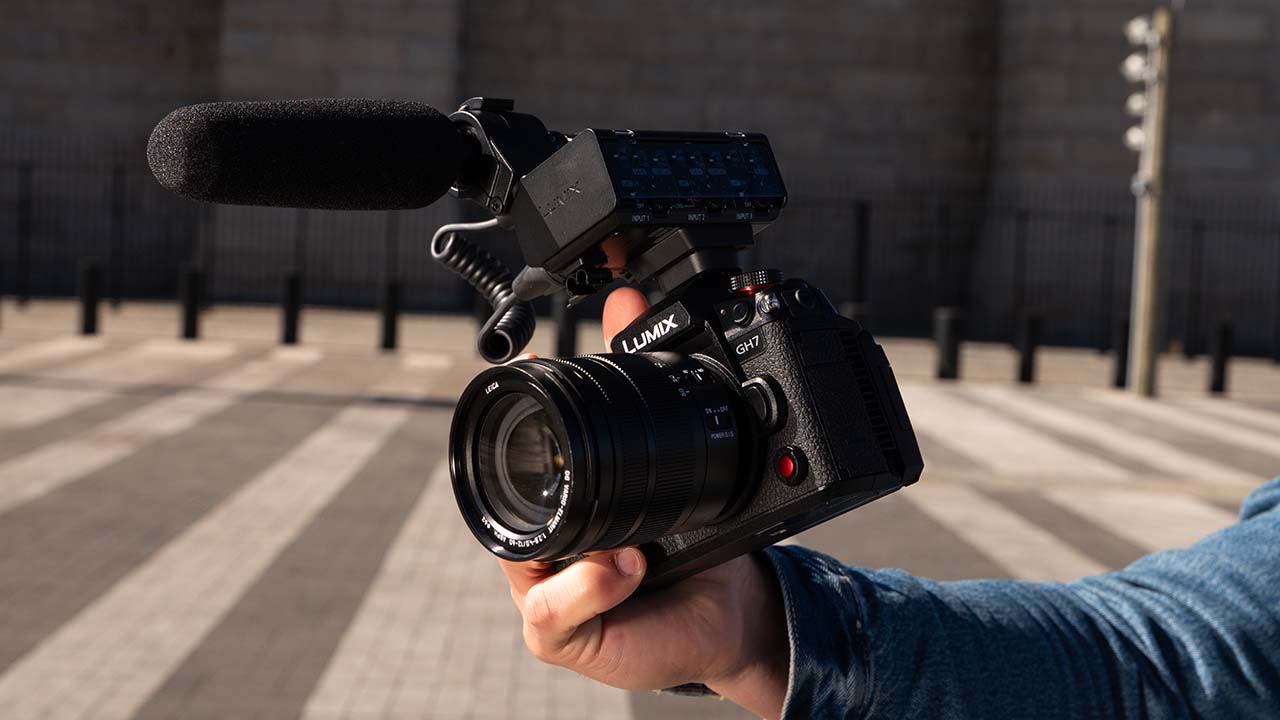
Panasonic has announced the GH7, a new MFT mirrorless camera that features on-board ProRes RAW recording and Arri Log-C compatibility.
Panasonic has announced a new Micro Four Thirds flagship mirrorless camera, with the focus very much on video. The new camera appears to be much more than a simple iterative update on the GH6, with some extremely significant new features that up the game somewhat.
It can be difficult to get excited by a new camera these days, since there's only minor variations between models and their capabilities. However, the LUMIX GH7 would seem to show that Panasonic is not taking the competition lying down. So, what's new, and why all the fuss?

Front view of the LUMIX GH7. Image: Panasonic.
LUMIX GH7 key features and specs
Sensor spec
Sensor wise, the GH7 features a 25.2MP BSI MFT CMOS. In keeping with all new LUMIX cameras, the sensor features phase-detect autofocus. Panasonic is claiming a maximum dynamic range of around 13-stops for 30p and below, and around 12-stops for up to 60p.
Although the GH7 is very much a video focussed device, and MFT isn't a first choice, generally, for stills photographers, the sensor does allow for some solid specifications in that regard. For instance, burst shooting with the mechanical shutter allows for up to 14fps. Switch to the electronic shutter, and you can expect up to 75fps burst speed. Okay, it's not the mind-bending 120fps and above that some Sony and Nikon cameras are capable of, but it's still going to satisfy those who might occasionally indulge in sports photography, an area in which an MFT sized sensor can often be quite useful.
Object tracking for the autofocus also features, recognising people, animals, cars and more. Interestingly the camera also now lets users choose which part of an object to focus on. For example the front or side of a car.
Not surprisingly, 5-axis IBIS is featured, giving what Pansonic claims is a 7.5stop advantage in stills mode. There's also an Active IS mode, which is designed to correct shaking when running. An Electronic IS mode is available for video shooting, and performs perspective distortion correction.

Rear quarter view of the LUMIX GH7. Image: Panasonic.
On-board ProRes RAW recording.
This is significant, because in previous generations it has required an external recording device to avoid patent issues. Now, whether Panasonic has done a deal with Nikon/RED, we'll probably never know. It would have been nice to see BRAW in addition, since not everyone uses FCP or Premiere Pro, but it is a notable development nevertheless.
ProRes RAW can be recorded in a 17:9 aspect at 5.7K resolution (5728×3024) at 23.98, 24, 25, and 29.97fps. A C4K option is also available (4096×2160), which adds in 50 and 59.94 frame rates.
More generally, there are a huge number of non ProRes RAW video modes available in 10-bit colour with either 4:2:0 or 4:2:2 colour sampling, depending on whether you are shooting above or below 4K resolution. The highest resolution here is 5.8K open gate 4:3 (5760×4320) which can be shot up to 30p.
Fans of slow motion can shoot 120fps in 4K or 240fps in FHD (1920x1080). There is also a VFR (variable frame rate) mode, which can cater up to 300fps in FHD resolution. Whether or not such high frame rates are being achieved with any form of line skipping remains to be seen. But, if 300fps is possible at a genuine 1080p resolution, it will mean that the GH7 will be a truly useful slow motion camera.
Recordings can be made to a CFast card, or to an external SSD. Low resolution proxy files can also be recorded simultaneously to the SD card slot. Lastly, there is no record time limit on any of the resolutions due to the camera featuring an active cooling system.
32-bit float audio
This is where things get interesting for me. We're gradually seeing 32-bit float making its way into more audio recording devices, such as DJI's Mic 2. But, it's rare to see it in a camera.
32-bit float audio gives users a huge amount of leeway during recording because it's pretty much impossible to reach a volume distortion point. Even the sound of a bomb going off next to it would struggle to peak the audio. With really good pre-amps, 32-bit float should also allow for the quietest parts of a recording to be brought up easily, too.
For single person run and gun or other shooting, 32-bit float audio recording takes a lot of the stress out of things, because you know that you won't have blown things out in the absence of having a dedicated sound op with you. On the GH7, 32-bit float audio recording requires the DMW-XLR2 device, which mounts onto the camera's hot shoe.
As the name suggests, the DMW-XLR2 gives XLR inputs, and also features a 3.5mm input jack, as well as catering to four channels of audio, up from two on the DMW-XLR1.
ARRI LOG-C
With the addition of the DMW-SFU3A license key, the GH7 can use ARRI's Log-C logarithmic curve for colour compatibility with ARRI's cameras. This won't gain you anything in terms of dynamic range over the alternative V-log mode, but it will make matching colour across cameras easier. It also enables users to download picture profiles from the ARRI Look Library. Though at $199.99, this functionality will be very niche. That said, the GH7 also features a Real Time LUT function, which lets you store up to 39 profiles and apply them to your video or stills.
Using the LUMIX Lab app, users can transfer over a still or video, create the look they want, and then transfer the resultant LUT back to the camera.
The Panasonic LUMIX GH7 will be available from July and will have an RRP of $2,197.99 for the camera body.
Tags: Production Cameras


Comments